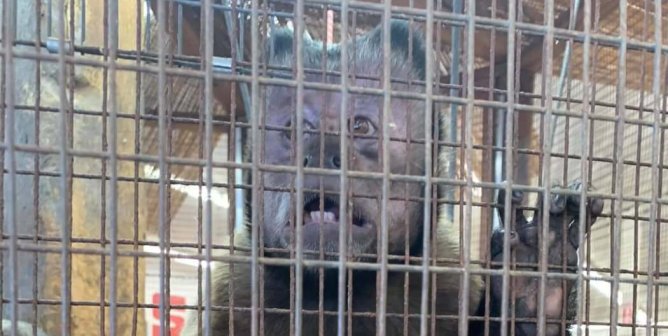Live Animal Acts and Exhibits: Anguished ‘Entertainers’
Ivan, a 500-pound gorilla, spent more than 26 years on display in a concrete cell in a shopping mall in Tacoma, Washington. In addition to being gawked at by crowds and denied sunlight and fresh air, Ivan was deprived of mental stimulation and contact with his own species.(1) After years of protests by people who were appalled by his living conditions, Ivan was finally moved to a spacious home. For the first time, he was able to venture outside, smell flowers, and join a gorilla family. Unfortunately, the life stories of most captive animals on display do not end so favorably.
Captives of Cruelty
There is a wide and deplorable range of animal acts and exhibits, including diving horses at theme parks, performing primates, caged bears at ice cream stands, bingo-playing chickens, parrots caged in hotel lobbies, cats forced to jump through flaming hoops, and giant turtles forced to give rides to children.
Animals used in these spectacles are often subjected to abuse in order to provide “entertainment” to patrons. Even under the best of circumstances and without forced performances, captivity can be hell for animals, who are meant to roam free. Kept in small, barren cages, with nothing to sleep on but concrete slabs, and imprisoned behind iron bars, captive animals often suffer from malnutrition, loneliness, deprivation of any opportunity to engage in natural behavior, loss of freedom and independence, lack of veterinary care, and filthy quarters. Attracting customers is their captors’ first priority, and the animals’ welfare is often the last.
Animals forced to perform are subjected to frightening and abusive training methods in order to coerce them into doing stressful, confusing, uncomfortable, and even painful acts. Training methods can include beatings, the use of electric prods, food deprivation, and drugging. Even though tigers, bears, lions, and primates shun contact with humans, babies are torn away from their mothers and forced to interact in public settings, such as photo ops and petting zoos.
Hauled in tractor-trailers from one venue to the next and confined to tiny cages, captive animals endure constant stress. Many suffer as a result of irregular feeding and watering as well as exposure to temperature extremes. Without exercise, they become listless, their immune systems weaken, and they become prone to sickness. Many resort to self-mutilation and other neurotic behavior in reaction to stress or relentless boredom. Torn away from their families, captive animals are deprived of all dignity as handlers control every aspect of their lives.
Animals Fight Back
It is not uncommon for frustrated captive animals to snap and rebel. The owner of a roadside zoo in Pine County, Minnesota, was killed by a 400-pound tiger when she entered the animal’s cage. She died of crushing injuries to her throat as well as blood loss after the tiger bit off her right foot and portions of both arms.(2)
Roy Horn of the Siegfried & Roy nightclub act was left with debilitating injuries after being attacked by a tiger named Montecore during a Las Vegas performance. Montecore bit Horn’s arm—prompting Horn to beat Montecore’s head with a microphone—and then lunged at his neck and dragged him off the stage “like a rag doll.”(3) Horn’s coworkers beat Montecore, who held onto Horn until he was blasted with a fire extinguisher. The incident could have been even worse had Montecore chosen to jump off the stage and attack members of the audience.
Countless people have been seriously injured, many fatally, as a result of attacks by captive big cats, bears, elephants, and primates. Visit PETA.org for more details.
Current Regulations Are Ineffective
The U.S. Department of Agriculture (USDA) enforces the federal Animal Welfare Act (AWA), which sets minimum housing and maintenance standards for confined animals. Not all animals are afforded protection: Horses, birds, reptiles, fish, and other cold-blooded animals are specifically excluded from the AWA.
The USDA employs approximately 100 inspectors who are responsible for overseeing more than 9,200 licensed facilities nationwide that house animals.(4) In 2005, the USDA’s inspector general issued a scathing report stating that animal welfare officials in the department’s Eastern region (which covers all licensees east of the Mississippi River) were “lax” in punishing zoos and other facilities where people or animals had been endangered. The report detailed one case in which the government failed to act against a zoo that had a history of violations, even after a child was hurt by a jaguar. In another instance, inspectors did not charge an unlicensed exhibitor whose monkey bit two preschool students.(5)
What You Can Do
Never patronize any exhibit that includes animal acts. Instead, enjoy innovative acts, such as Cirque du Soleil or the Pickle Family Circus, or observe animals without interference in their natural environments.
If a local mall, hotel, or other establishment features an animal act or exhibit or allows one to set up in its parking lot, voice your concerns to the manager or store owner. Explain the facts about behind-the-scenes abuse and neglect, and explain the risk of injury to spectators. Have your friends and neighbors do the same, and make it clear that you will boycott the establishment until a “no animal displays” policy is implemented.
Inspect the exhibit for violations of state and federal laws. Watch for signs of poor health, such as listlessness, sores, lameness, missing hair, or self-mutilation. Note sanitation, food and water availability, and cage size (cages must be large enough for the animals to move around normally). Take photographs or video footage of the animals and their cages. If you see possible violations, try to get a sympathetic veterinarian to verify your findings. Then, contact your local humane officer or animal warden and the sector office of the USDA, which enforces the AWA. (Call the USDA at 202-720-3668 to find out the location and phone number of the sector office nearest you.) Insist that the animals be examined and that the conditions be improved.
Contact PETA for a supply of fliers and an “animal display ban” pack for tips on getting animal acts banned in your community. Organize demonstrations. See PETA’s factsheets on zoos and traveling animal acts for more information.
References
1) “A Gorilla Sulks in a Mall as His Future Is Debated,” The New York Times 17 Oct. 1993.
2) Kevin Giles, “Tiger That Killed Woman Was 100 Lbs. Underweight,” Star Tribune 11 Apr. 2006.
3) Adam Goldman, “Tiger Attacks Vegas Illusionist Roy Horn During ‘Siegfried and Roy’ Show,” Associated Press, 4 Oct. 2003. 4) Animal and Plant Health Inspection Service, “Animal Care Annual Report of Activities: Fiscal Year 2007,” U.S. Department of Agriculture, Sept. 2008.
5) Libby Quaid, “Audit Says Animal Welfare Officials More Lax,” Associated Press, 20 Oct. 2005.








